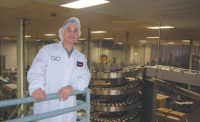I spent my afternoon today walking through a turkey processing plant and learning the backstory of a four-generation company. In many ways, they were a very technologically savvy company – their food safety practices included things I had never seen in a meat plant, and I’m looking forward to telling more of their story in the April issue of Independent Processor.
In other ways, this company was doing things with very traditional methods. That’s not a bad thing, either. By adhering to core beliefs and production practices, it has become known for its high-quality, artisan-type products. Its retail and foodservice customers are looking for quality they can’t find elsewhere, and they’re willing to pay a little more for that quality. They found the way to combine the efficiency that technology offers with old-school craftsmanship to get the best products.
I’ve seen some amazing technology in the meat plants I have visited. I’ve steaks sliced faster than the eye can see and burgers formed, grilled and frozen without being touched by human hands. Robotics have made their way into the meat plant, even small ones. Given the low unemployment numbers, many companies have had to look for way to utilize their work force in the best configuration. Investing in equipment that can do the work of two or three workers allows the manager to put those employees in other areas of the plant that need help.
Efficiency, though, does not guarantee quality. Quality can sometimes be an extremely inefficient process. In many ways, it seems like some development that were considered advancements in the food industry didn’t result in better products. They merely resulted in mediocre food that could be made quickly, and people accepted it as a necessary sacrifice in the name of progress.
The consumer trends of today are a revolt against efficiency. For example, raising animals to organic, pasture-raised or antibiotic-free standards can take more work and more time, compared to the conventional production methods that get animals to harvest as quickly as possible. The food industry as a whole turned to mass production over the last few decades, only to find consumers increasingly interested in small-batch, craft food items. Additives and artificial flavors that were developed to replace natural ingredients are falling out of favor, as consumers increasingly demand the actual ingredients.
Where does this leave a processor? There is a place for technology, automation and convenience in a meat processing operation, as long as they are implemented for the right reasons – increase consistency or food safety, for example. Any changes that have a negative impact on the taste or texture of your products should be carefully considered. Would you rather be known as a high-quality meat company, or just another business that makes mediocre food quickly?




